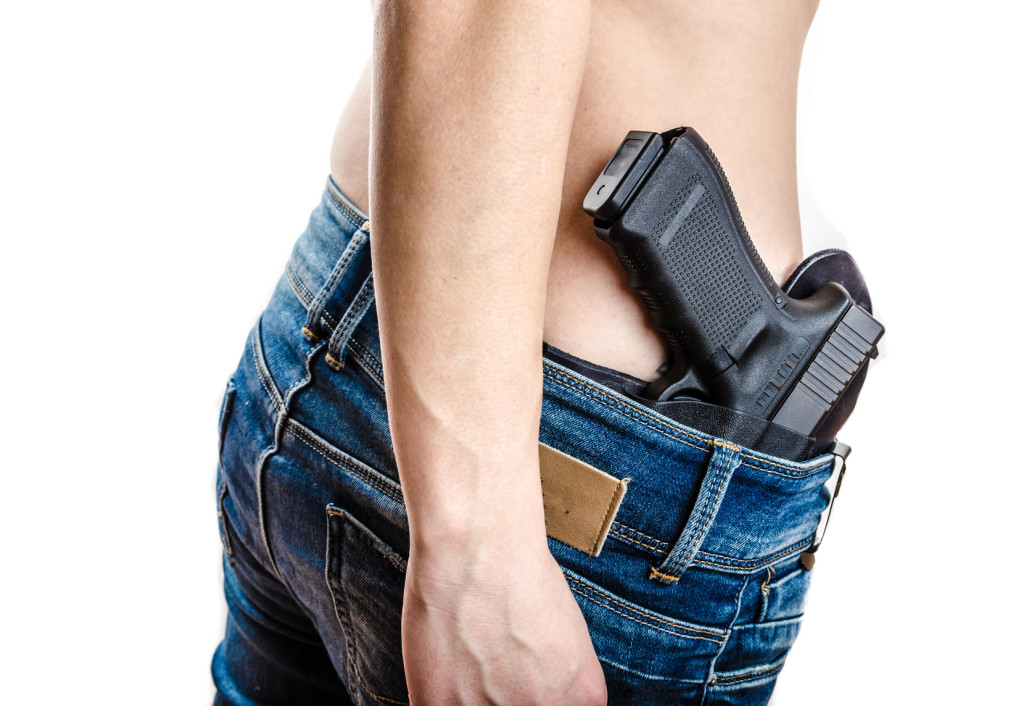It’s a cinch to carry without printing in the winter months. All the heavy clothing makes it simple to keep your firearm out of the prying eyes of others. Doing the same during the summer months, on the other hand, is a totally different matter.
When it’s 80 degrees plus outside, there aren’t many easy options to cover up your firearm. Therefore, it becomes much easier to accidentally expose your firearm to public observers and passersby.
Here are five simple tips to make sure your concealed weapon stays your business, and your business only.
1. Choose the Smallest Acceptable Firearm
From The Well Armed Woman:
Although not the ideal solution, as we don’t want to give up firepower if we don’t have to, carrying a smaller gun in the summer months is an option and is better than not carrying any gun at all. If you can afford a second gun, the very small and compact semi-automatics and lightweight revolvers are very easy to hide. Some are now so slim that they don’t create a bulge, (and who needs more of those?) You may want to research the available holsters for these models prior to purchasing to make sure the type of holster you want to wear is available for it. Keep in mind that smaller, lighter guns will have quite a bit more recoil to contend with. They simply don’t have the weight and size necessary to absorb the energy.
2. Try an Inside the Waistband (IWB) Holster
From American Concealed:
Inside the Waistband (IWB) holsters are a less revealing option and fit nicely under a t-shirt and pants. These give the handgun a low profile, rather than allowing the gun to bulge out along the waistline. Choose a smaller, more compact weapon because a larger model may dig into your torso or leg.
3. Utilize Deep Concealment
From Second Call Defense:
Your choices for deep concealment seem almost endless these days, including belly bands, appendix carry pouches, and bra holsters. Some of these methods require you to get past clothing used as cover, which makes drawing more difficult. But assuming you practice and feel comfortable that you can draw effectively in a high-stress situation, these are all additional options to consider.
Whether you change your method of carry for one day or the entire season, remember the importance of becoming familiar with your method of carry. Practice with an unloaded firearm and work out all the kinks in your draw stroke. It has to become second nature.
In a life-or-death situation, you won’t have time to think. You’ll have about 1.5 seconds and will have to depend on muscle memory to deploy your weapon properly.
A smaller firearm, for example, has a smaller grip and a shorter distance between the front and rear sight, making it more difficult to score accurate hits. Dry fire practice is essential. Remember, all it takes is a little time and effort to build muscle memory with your secondary firearm or alternate method of carry. You’re not starting from scratch. You’re simply building on your existing skills to create a new skill set with different equipment.Your choices for deep concealment seem almost endless these days, including belly bands, appendix carry pouches, and bra holsters. Some of these methods require you to get past clothing used as cover, which makes drawing more difficult. But assuming you practice and feel comfortable that you can draw effectively in a high-stress situation, these are all additional options to consider.
Whether you change your method of carry for one day or the entire season, remember the importance of becoming familiar with your method of carry. Practice with an unloaded firearm and work out all the kinks in your draw stroke. It has to become second nature.
In a life-or-death situation, you won’t have time to think. You’ll have about 1.5 seconds and will have to depend on muscle memory to deploy your weapon properly.
A smaller firearm, for example, has a smaller grip and a shorter distance between the front and rear sight, making it more difficult to score accurate hits. Dry fire practice is essential. Remember, all it takes is a little time and effort to build muscle memory with your secondary firearm or alternate method of carry. You’re not starting from scratch. You’re simply building on your existing skills to create a new skill set with different equipment.
How Do You Carry In Hot Weather?
Do you have any good tips for keeping your concealed weapon concealed when the mercury starts to climb? Drop your advice in the comments!

